Cleebronn
![]() Cleebronn is a municipality in the district of Heilbronn in Baden-Württemberg in southern Germany.
Cleebronn is a municipality in the district of Heilbronn in Baden-Württemberg in southern Germany.
Cleebronn | |
|---|---|
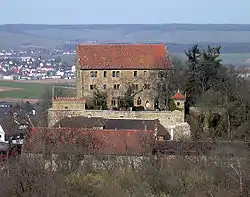 Magenheim castle | |
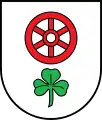 Coat of arms | |
Location of Cleebronn within Heilbronn district  | |
 Cleebronn 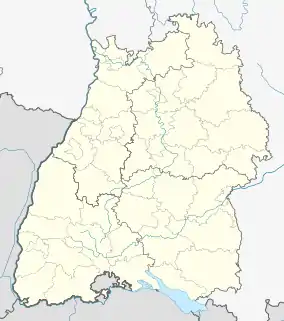 Cleebronn | |
| Coordinates: 49°3′N 9°2′E | |
| Country | Germany |
| State | Baden-Württemberg |
| Admin. region | Stuttgart |
| District | Heilbronn |
| Government | |
| • Mayor | Thomas Vogl |
| Area | |
| • Total | 17.09 km2 (6.60 sq mi) |
| Elevation | 236 m (774 ft) |
| Population (2019-12-31)[1] | |
| • Total | 3,053 |
| • Density | 180/km2 (460/sq mi) |
| Time zone | UTC+01:00 (CET) |
| • Summer (DST) | UTC+02:00 (CEST) |
| Postal codes | 74389 |
| Dialling codes | 07135 |
| Vehicle registration | HN |
| Website | www.cleebronn.de |
Geography
Cleebronn is in the Zabergäu in the south of the district of Heilbronn, directly in the north of the Stromberg mountain with an elevation of 220 to 260 metres (720 to 850 ft). The landscape is characterized by wine-growing. The symbol of the municipality and even the whole Zabergäu is the Michaelsberg with an elevation of 394 metres (1,293 ft).
Neighbouring municipalities
Neighbouring towns of Cleebronn are (clockwise from the west): Güglingen, Brackenheim (both in the district of Heilbronn), Bönnigheim and Sachsenheim (both in the district of Ludwigsburg). Cleebronn has combined with Brackenheim to form a joint association of administrations.
Municipal structure
Cleebronn includes the villages of Treffentrill and Katharinenplaisir.
History
Cleebronn was first mentioned documentary in 1279 as Kleberen. In the 13th century there were some possessions of the Principality of Mainz around the Michaelsberg being rent to Cleebronn's Lords of Magenheim.
In the 14th century Württemberg acquired around two-thirds of the village as Württembergisch Cleebronn. The other third stayed in possession of the principality as Mainzisch Cleebronn. In 1785 Württemberg acquired this last third but stayed independent. These municipalities staying independent until 1843 had been called Alt-Cleebronn and Neu-Cleebronn until 1811. These two parts were not united until January 1, 1844.
In Cleebronn there is a Protestant parish.
Politics
District council
Following the municipal election of 13 June 2004, the district council of Cleebronn has 12 seats. The election result is as follows:
| party | amount | +/− | seats | +/− |
| FWV | 42.2% | (+2.3) | 5 | (=) |
| CDU | 38.0% | (−7.5) | 5 | (−1) |
| Arbeitsgemeinschaft Umwelt (AGU) | 19.7% | (+5.1) | 2 | (+1) |
The mayor is also a member of the district council and its chairman.
Culture and sights
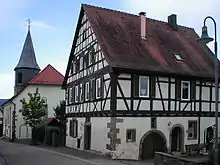
Notable buildings
- The Protestant Raphaelskirche consists of Gothic parts and got redeveloped in 1900–01. Next to the church is the old vicarage.
- The current town hall was built in 1736 and has been redeveloped several times.
- The Bürgerhaus got built in 1902 as a school instead of the old town hall. School ended in 1994, after it got moderned until 1997.
- The wine-press of the village is of 1907 and formerly has been the biggest wine-press of Württemberg.
- The Backhaus got built in 1930 and redeveloped in 1985, it contains two functional ovens.
- Above the village on a hill is Magenheim Castle, a building of the Staufers built in 1250 and formerly seat of the Lords of Magenheim.
- On the Michaelsberg there is a Romanic church and a spital of 1739 (today's youth hostel).
- The hamlet Katharinenplaisir is a Baroque estate built in 1733 and named after the builder's wife.
- Situated at the communal land of Cleebronn with an elevation of 472 metres (1,549 ft), there is the highest point of the Stromberg mountain ridge. On top of it a telecommunication's tower was built in 1969.
 town hall
town hall Backhaus of 1930
Backhaus of 1930 wine-press of 1907
wine-press of 1907 inside the Michaelskirche
inside the Michaelskirche
Economy and infrastructure
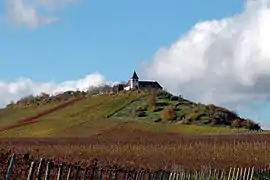
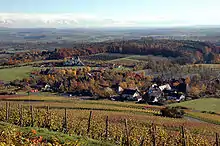
Wine-growing
On the Michaelsberg people grow wine for 1200 years. There are growing different varietals like blaufränkisch, trollinger, riesling and Kerner. Most wine-growers belong to the Weingärtnergenossenschaft Weingärtner Cleebronn-Güglingen eG.
Transportation
There are connections to the long-distance network via Lauffen and Kirchheim (B 27). Public transport is ensured by buses of the HNV. There's also a connection to the rail network in Lauffen and Kirchheim (Frankenbahn). The Zabergäubahn being shut down for several years has a station in the neighbouring Frauenzimmern. According to current plannings the rail is to be redeveloped until 2011. However, according to a report of July 2006, this is very doubtful.[2]
Local businesses
A well-known employee is Zink Feuerwerk GmbH, producing fireworks. Founded in 1949, the company goes back to an old trade with fireworks founded in 1852. It is one of the last producers of fireworks in Germany and produces both rockets and big fireworks, containing 20 employers. Both the founder Paul Zink and his son and successor Walter got hold up to honorary citizens of Cleebronn.[3]
Media
About happenings in Cleebronn, the daily paper Heilbronner Stimme informs within its edition SW, south-west.
Education
The primary school Friedrich-Hölderlin-Grundschule in Cleebronn has a new building since 1994. Secondary schools are situated within Cleebronn's neighbouring towns. Besides there are two kindergartens held by the Protestant church. Also Cleebronn has a small library within its Bürgerhaus as well as a separate book store selling used books.
Leisure

Below the Michaelsberg there's the Erlebnispark Tripsdrill. Next to it, the Wildparadies Stromberg (wildlife park) is connected. On a surface of 77 hectares (190 acres) there are around 100 attractions, zoological institutions and museums to visit. Near the park is the tennis ground of the TC Cleebronn, which has five places to play and a further one to play beach-volleyball.
Sons and daughters of the community
- Sigismund Wilhelm Koelle (1820-1902), missionary and linguistic researcher
- Carl Krauch (1853-1934), chemist
References
- "Bevölkerung nach Nationalität und Geschlecht am 31. Dezember 2019". Statistisches Landesamt Baden-Württemberg (in German). September 2020.
- Thomas Dorn: Die Stadtbahn ins Zabergäu ist derzeit nicht zu bezahlen. In: Heilbronner Stimme of July 11th, 2006, p. 30.
- History Archived 2010-12-15 at the Wayback Machine at zink-feuerwerk.com (retrieved on May 18, 2008)
Joachim Rüeck: Der Rummel kam erst nach dem 70. Geburtstag. In: Heilbronner Stimme of July 19, 2004
Klaus Thomas Heck: Die dicke Berta kommt aus China. In: Heilbronner Stimme of December 30, 2006
External links
- www.cleebronn.de (in German)
